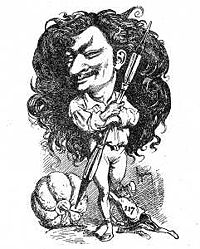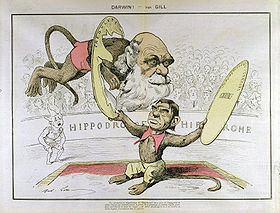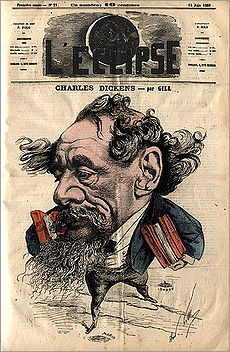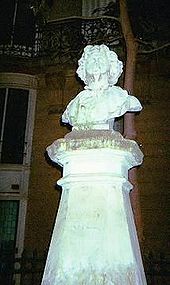
André Gill
Encyclopedia

France
The French Republic , The French Republic , The French Republic , (commonly known as France , is a unitary semi-presidential republic in Western Europe with several overseas territories and islands located on other continents and in the Indian, Pacific, and Atlantic oceans. Metropolitan France...
caricaturist
Caricature
A caricature is a portrait that exaggerates or distorts the essence of a person or thing to create an easily identifiable visual likeness. In literature, a caricature is a description of a person using exaggeration of some characteristics and oversimplification of others.Caricatures can be...
. Born Louis-Alexandre Gosset de Guînes at Paris
Paris
Paris is the capital and largest city in France, situated on the river Seine, in northern France, at the heart of the Île-de-France region...
, the son of the Comte de Guînes
Guînes
Guînes is a commune in the Pas-de-Calais department in northern France.-Geography:Guînes is located on the border of the two territories of the Boulonnais and Calaisis, at the edge of the now-drained marshes, which extend from here to the coast. The Guînes canal connects with...
and Sylvie-Adeline Gosset, he studied at this city's Academy of Fine Arts
Académie de peinture et de sculpture
The Académie royale de peinture et de sculpture , Paris, was founded in 1648, modelled on Italian examples, such as the Accademia di San Luca in Rome. Paris already had the Académie de Saint-Luc, which was a city artist guild like any other Guild of Saint Luke...
. He adopted the pseudonym
Pseudonym
A pseudonym is a name that a person assumes for a particular purpose and that differs from his or her original orthonym...
André Gill in homage to his hero, James Gillray
James Gillray
James Gillray , was a British caricaturist and printmaker famous for his etched political and social satires, mainly published between 1792 and 1810.- Early life :He was born in Chelsea...
.http://www.thinker.org/legion/exhibitions/exhibition.asp?exhibitionkey=513 Gill began illustrating for Le Journal Amusant. Gill, however, became known for his work for the weekly four-sheet newspaper La Lune
La Lune
La Lune was the name of a nineteenth-century French weekly four-sheet newspaper edited by Francis Polo. The illustrator André Gill became known for his work for this journal, in which he drew caricatures for a series entitled The Man of the Day.Napoleon III disliked the portrait of him drawn by...
, edited by Francis Polo, in which he drew portraits for a series entitled The Man of the Day. He worked for La Lune from 1865 to 1868. When La Lune was banned, he worked for the periodical L'Éclipse
L'Éclipse
L'Éclipse was a French newspaper of the nineteenth century, appearing from 1868 to 1876. Edited by Francis Polo, L'Éclipse was a showcase for the illustrator André Gill, in which he drew caricatures of his illustrious contemporaries....
from 1868 to 1876. Gill also drew for famous periodical Le Charivari
Le Charivari
Le Charivari was an illustrated newspaper published in Paris, France from 1832 to 1937. It published caricatures, political cartoons and reviews...
.
Caricatures

Sarah Bernhardt
Sarah Bernhardt was a French stage and early film actress, and has been referred to as "the most famous actress the world has ever known". Bernhardt made her fame on the stages of France in the 1870s, and was soon in demand in Europe and the Americas...
, Otto von Bismarck
Otto von Bismarck
Otto Eduard Leopold, Prince of Bismarck, Duke of Lauenburg , simply known as Otto von Bismarck, was a Prussian-German statesman whose actions unified Germany, made it a major player in world affairs, and created a balance of power that kept Europe at peace after 1871.As Minister President of...
, Émile Zola
Émile Zola
Émile François Zola was a French writer, the most important exemplar of the literary school of naturalism and an important contributor to the development of theatrical naturalism...
, Victor Hugo
Victor Hugo
Victor-Marie Hugo was a Frenchpoet, playwright, novelist, essayist, visual artist, statesman, human rights activist and exponent of the Romantic movement in France....
, Nadar
Nadar (photographer)
Félix Nadar was the pseudonym of Gaspard-Félix Tournachon , a French photographer, caricaturist, journalist, novelist and balloonist. Some photographs by Nadar are marked "P. Nadar" for "Photographie Nadar" .-Life: born in April 1820 in Paris...
, Giuseppe Garibaldi
Giuseppe Garibaldi
Giuseppe Garibaldi was an Italian military and political figure. In his twenties, he joined the Carbonari Italian patriot revolutionaries, and fled Italy after a failed insurrection. Garibaldi took part in the War of the Farrapos and the Uruguayan Civil War leading the Italian Legion, and...
, Adelina Patti
Adelina Patti
Adelina Patti was a highly acclaimed 19th-century opera singer, earning huge fees at the height of her career in the music capitals of Europe and America. She first sang in public as a child in 1851 and gave her last performance before an audience in 1914...
, Charles Dickens
Charles Dickens
Charles John Huffam Dickens was an English novelist, generally considered the greatest of the Victorian period. Dickens enjoyed a wider popularity and fame than had any previous author during his lifetime, and he remains popular, having been responsible for some of English literature's most iconic...
, and Richard Wagner
Richard Wagner
Wilhelm Richard Wagner was a German composer, conductor, theatre director, philosopher, music theorist, poet, essayist and writer primarily known for his operas...
.

Napoleon III of France
Louis-Napoléon Bonaparte was the President of the French Second Republic and as Napoleon III, the ruler of the Second French Empire. He was the nephew and heir of Napoleon I, christened as Charles Louis Napoléon Bonaparte...
disliked the portrait of him drawn by Gill. In December 1867, La Lune was censored
Censorship
thumb|[[Book burning]] following the [[1973 Chilean coup d'état|1973 coup]] that installed the [[Military government of Chile |Pinochet regime]] in Chile...
. "La Lune will have to undergo an eclipse
Eclipse
An eclipse is an astronomical event that occurs when an astronomical object is temporarily obscured, either by passing into the shadow of another body or by having another body pass between it and the viewer...
," an authority commented to Editor Francis Polo when the ban was instituted, unwittingly dubbing Polo's subsequent publication: L'Éclipse, which made its first appearance on 9 August 1868.http://freresgoncourt.free.fr/portefeuilleplus/Gill/gill.htm Gill would contribute caricatures to this successor of La Lune as well.
In 1868, Gill faced a lawsuit
Lawsuit
A lawsuit or "suit in law" is a civil action brought in a court of law in which a plaintiff, a party who claims to have incurred loss as a result of a defendant's actions, demands a legal or equitable remedy. The defendant is required to respond to the plaintiff's complaint...
after drawing a pumpkin
Pumpkin
A pumpkin is a gourd-like squash of the genus Cucurbita and the family Cucurbitaceae . It commonly refers to cultivars of any one of the species Cucurbita pepo, Cucurbita mixta, Cucurbita maxima, and Cucurbita moschata, and is native to North America...
that was believed by the magistrates to represent the head of a judge. Ever since Charles Philipon
Charles Philipon
Charles Philipon . Born in Lyon, he was a French lithographer, caricaturist and journalist. He was the editor of the La Caricature and of Le Charivari, both satirical political journals....
had drawn a pear
Pear
The pear is any of several tree species of genus Pyrus and also the name of the pomaceous fruit of these trees. Several species of pear are valued by humans for their edible fruit, but the fruit of other species is small, hard, and astringent....
to represent Louis Philippe
Louis-Philippe of France
Louis Philippe I was King of the French from 1830 to 1848 in what was known as the July Monarchy. His father was a duke who supported the French Revolution but was nevertheless guillotined. Louis Philippe fled France as a young man and spent 21 years in exile, including considerable time in the...
, any fruit drawn by caricaturists was believed to carry satirical value and was suspect in the eyes of the court. Gill's lawsuit brought him fame –as well as a prison sentence. He was, however, released after a short time.
His fame won him entry into the Bohemian
Bohemian
A Bohemian is a resident of the former Kingdom of Bohemia, either in a narrow sense as the region of Bohemia proper or in a wider meaning as the whole country, now known as the Czech Republic. The word "Bohemian" was used to denote the Czech people as well as the Czech language before the word...
artistic world of Paris; Gill met Charles Cros
Charles Cros
Charles Cros was a French poet and inventor. He was born in Fabrezan, Aude, France, 35 km to the East of Carcassonne....
and Paul Verlaine
Paul Verlaine
Paul-Marie Verlaine was a French poet associated with the Symbolist movement. He is considered one of the greatest representatives of the fin de siècle in international and French poetry.-Early life:...
. During a trip to Paris, Rimbaud, who admired Gill's drawings from L'Éclipse, stopped at the caricaturist's house. Gill found the poet prostate on a settee. After Rimbaud explained himself, Gill gave him some money and advised him to leave Paris before war
Franco-Prussian War
The Franco-Prussian War or Franco-German War, often referred to in France as the 1870 War was a conflict between the Second French Empire and the Kingdom of Prussia. Prussia was aided by the North German Confederation, of which it was a member, and the South German states of Baden, Württemberg and...
erupted.
In September 1871, Gill caricatured the statesman Adolphe Thiers
Adolphe Thiers
Marie Joseph Louis Adolphe Thiers was a French politician and historian. was a prime minister under King Louis-Philippe of France. Following the overthrow of the Second Empire he again came to prominence as the French leader who suppressed the revolutionary Paris Commune of 1871...
, who became his favorite target in L’Éclipse, which had resumed publication in June 1871. In 1872, his work for this paper became regular. In an 1873 attack against the government's censorship of his work, Gill drew "L’Enterrement de la caricature" ("The Funeral of Caricature") in which an artist follows a hearse
Hearse
A hearse is a funerary vehicle used to carry a coffin from a church or funeral home to a cemetery. In the funeral trade, hearses are often called funeral coaches.-History:...
that carries a dog holding a pen and a paintbrush. In 1875, he drew "Le journaliste et l’avenir" ("The Journalist and the Future"), in which a journalist is depicted bound and gagged.
L'Éclipse, which disappeared after 1876, was replaced by the periodical La Lune rousse ("The Red Moon") (1876–1879), of which Gill served as the editor. Refusing to engage in any continuous political struggle, he quarreled with his old friend Jules Vallès
Jules Vallès
Jules Vallès was a French journalist and author.-Early life:Vallès was born in Le Puy-en-Velay, Haute-Loire. His father was a supervisor of studies , later a teacher, and unfaithful to Jules' mother. Jules was a brilliant student...
. Gill preferred the Bohemian life and its excesses.
On 29 July 1881, France changed its censorship laws, allowing that "any newspaper or periodic writing can be published, without preliminary authorization and deposit of guarantee."http://www.oulala.net/Portail/imprimer.php3?id_article=914 Gill, however, was not able to enjoy these new journalistic freedoms as he was forced to enter a psychiatric hospital.
Other activities

Musée du Luxembourg
Musée du Luxembourg is a museum in Paris, France. It occupies the east wing of the Palais du Luxembourg, whose matching west wing originally housed Ruben's Marie de' Medici cycle. Since 2000 it has been run by the French Ministry of Culture and the Senate and is devoted to temporary exhibitions...
on 15 May 1871, in which capacity he reassembled the scattered collections of art and reestablished the museum of sculpture
Sculpture
Sculpture is three-dimensional artwork created by shaping or combining hard materials—typically stone such as marble—or metal, glass, or wood. Softer materials can also be used, such as clay, textiles, plastics, polymers and softer metals...
. He had scarcely begun his work when it was interrupted by the upheaval associated with the Paris Commune
Paris Commune
The Paris Commune was a government that briefly ruled Paris from March 18 to May 28, 1871. It existed before the split between anarchists and Marxists had taken place, and it is hailed by both groups as the first assumption of power by the working class during the Industrial Revolution...
.
Gill became involved in the Paris Commune. During this conflict, he illustrated for Jules Vallès'
Jules Vallès
Jules Vallès was a French journalist and author.-Early life:Vallès was born in Le Puy-en-Velay, Haute-Loire. His father was a supervisor of studies , later a teacher, and unfaithful to Jules' mother. Jules was a brilliant student...
socialist paper, La Rue.
In 1870, Gustave Courbet
Gustave Courbet
Jean Désiré Gustave Courbet was a French painter who led the Realist movement in 19th-century French painting. The Realist movement bridged the Romantic movement , with the Barbizon School and the Impressionists...
established a "Federation of Artists" for the free and uncensored expansion of art. The group's members included Gill, Honoré Daumier
Honoré Daumier
Honoré Daumier was a French printmaker, caricaturist, painter, and sculptor, whose many works offer commentary on social and political life in France in the 19th century....
, Jean-Baptiste Camille Corot, Eugène Pottier, Jules Dalou
Jules Dalou
Aimé-Jules Dalou was a French sculptor, recognized as one of the most brilliant virtuosos of nineteenth-century France, admired for his perceptiveness, execution, and unpretentious realism.-Life:...
, and Manet
Édouard Manet
Édouard Manet was a French painter. One of the first 19th-century artists to approach modern-life subjects, he was a pivotal figure in the transition from Realism to Impressionism....
.
In 1875, Gill painted the sign that was to suggest the name of the famous night-club Lapin Agile
Lapin Agile
Lapin Agile is a famous Montmartre cabaret, at 22 Rue des Saules, 18th arrondissement of Paris, France.It was originally called "Cabaret des Assassins". Tradition relates that the cabaret received this name because a band of assassins broke in and killed the owner's son...
. It was a picture of a rabbit
Rabbit
Rabbits are small mammals in the family Leporidae of the order Lagomorpha, found in several parts of the world...
jumping out of a saucepan, and locals began calling their neighborhood night-club "Le Lapin à Gill": "Gill's rabbit". Over time, this name evolved into "Lapin Agile", or "Nimble Rabbit".
Death

Mental illness
A mental disorder or mental illness is a psychological or behavioral pattern generally associated with subjective distress or disability that occurs in an individual, and which is not a part of normal development or culture. Such a disorder may consist of a combination of affective, behavioural,...
and died five years later, May Day
May Day
May Day on May 1 is an ancient northern hemisphere spring festival and usually a public holiday; it is also a traditional spring holiday in many cultures....
, 1885, at the asylum of Charenton
Charenton (asylum)
Charenton was a lunatic asylum, founded in 1645 by the Frères de la Charité in Charenton-Saint-Maurice, now Saint-Maurice, Val-de-Marne, France....
with only Emile Cohl
Émile Cohl
Émile Cohl , born Émile Eugène Jean Louis Courtet, was a French caricaturist of the largely forgotten Incoherent Movement, cartoonist, and animator, called "The Father of the Animated Cartoon" and "The Oldest Parisian".-Biography:Émile's father Elie was a rubber salesman, and his mother, Emilie...
, friend and colleague, at his side. His other friends and the public overall, had deserted him. Charenton asylum had famously served as the home of the Marquis de Sade
Marquis de Sade
Donatien Alphonse François, Marquis de Sade was a French aristocrat, revolutionary politician, philosopher, and writer famous for his libertine sexuality and lifestyle...
.
The small Rue André Gill (perpendicular to the Rue des Martyrs), in the Montmartre
Montmartre
Montmartre is a hill which is 130 metres high, giving its name to the surrounding district, in the north of Paris in the 18th arrondissement, a part of the Right Bank. Montmartre is primarily known for the white-domed Basilica of the Sacré Cœur on its summit and as a nightclub district...
district of Paris, is named after him. His bust
Bust (sculpture)
A bust is a sculpted or cast representation of the upper part of the human figure, depicting a person's head and neck, as well as a variable portion of the chest and shoulders. The piece is normally supported by a plinth. These forms recreate the likeness of an individual...
is situated at the end of the street. In 2000, the bust was found reversed; it has since been restored. The Hotel André Gill is also located on this street.
Sources
Andre Gill Encyclopedia Britannica: André Gill Frères Goncourt: GillExternal links
- Gallery of Caricatures by André Gill
- Works by André Gill at HeidICON access via "Gast-Zugang"

